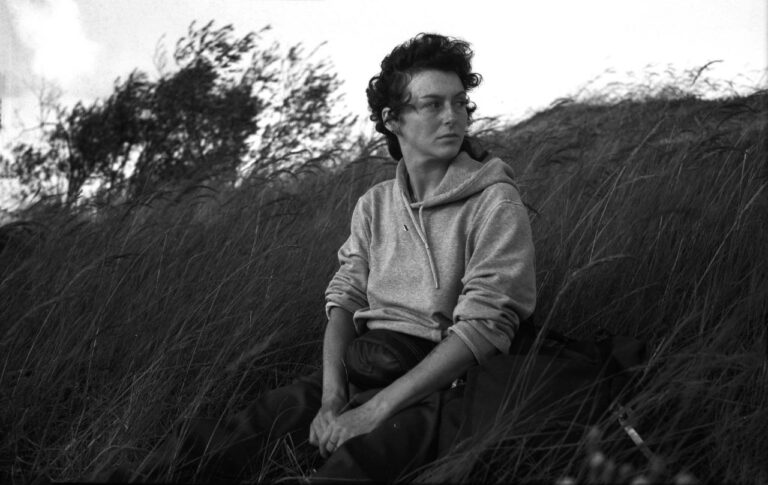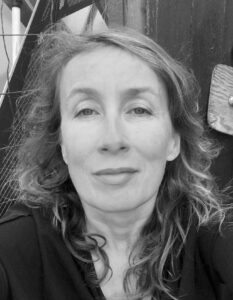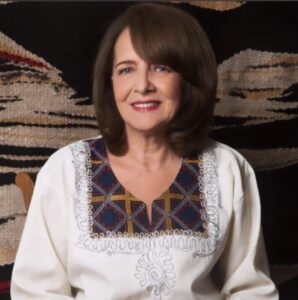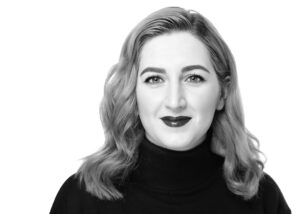Inga Levi / Інга Леві

– born in 1986 in Kyiv. She works with graphics, painting, mosaic, installation, and at the intersection of various media. She graduated from the publishing and printing Department of National Technical University of Ukraine KPI, specializing in book illustration. In 2021, she completed a Contemporary Art course at KAMA. From 2018 to 2021, she was the curator of mosaic works for the restoration of the “Stars and Constellations” fountain and the restoration of the monumental decor of the Kyiv Central Bus Station designed by Rybachuk and Melnychenko. In 2021, she became a fellow of the Gaude Polonia program in Lublin, Poland. From 2022 to 2024, she is studying at the Gdańsk Academy of Fine Arts, Faculty of Intermedia.
After February 24th, it became clear to me once and for all that art cannot be apolitical. At the moment when Russia was bombing all of Ukraine, I found myself in the remote mountain village of Kryvorivnya, where on March 1st, the museum of Paraska Plytka-Horytsvit was to open. This artist, during long hard years of exile in camps, wrote poems and prose. Perhaps it was her figure that helped me dare to act as an artist. The significance of artistic activity was revived for me. My medium became compact, portable materials that can be carried under any circumstances. On February 26th, I began a series of drawings Double Exposure123, where the dual perception of the horrific news about the war in my own country and at the same time my stay in a safe place merged.
For the third year now, I continue the graphic project “Double Exposure.” Over time, it has changed from documentary and therapeutic to traumatic, forced, and routine. Eventually, it turned into a diary, a personal necessity.
In March 2022, I found myself in Lithuania as a refugee. By the summer, on the pier of Nida facing the Russian border on the horizon, I created a site-specific installation Shelter4, dedicated to the experience of fleeing from the war. Not so much my own, but rather the experience of the people I crossed paths with during this time.
After that, I implemented my only plan available since 2021: to enroll in the Academy of Arts in Gdańsk, Poland. Abroad, a significant reassessment of the concept of “home” occurred.
During my studies, I experienced a paradoxical sense of “privilege” due to my national tragedy. While students hesitate over which topic to work with, I have one topic – war, because it seems impossible to bypass this “grand narrative.” For example, Playground missile56, which I realized in the form of a model – about the Soviet “legacy” that returned to us with its previously unobvious side.
At the same time, the studies provide an opportunity to experiment with media. In the workshop of transdisciplinary activity by Professor Grzegorz Klaman, the work S dobrym utrom! [in Russian: “Good Morning!”]7 appeared. In it, I use a Ukrainian towel from the 60s with an inscription in Russian, found video footage in which the singing of starlings imitates the whistle of artillery, and a hint at a military stretch and a motion sensor that triggers the sound.
As part of my thesis, I turned to the theme of commemoration, which has long interested me. I plan to develop alternative projects to honor the military students of the Kyiv Polytechnic Institute (KPI) instead of the community-criticized mural project by the institute’s administration.
The first mention of the “Soviet legacy” in this text has an obvious negative connotation. However, this pertains more to the political and social dimensions. Developing a commemorative project for KPI raises the issue of how we regard the cultural heritage of the Soviet era. Amidst wartime, this issue might seem “out of place.” Yet, are we not denying our own heritage and a part of our identity by stigmatizing the material, architectural, and cultural heritage created by Ukrainian artists as “Soviet”?
Defending and promoting monumental art is a way to preserve this legacy despite ongoing destruction, as well as a reason for community unification.
I was involved in one of the first projects to restore Ukrainian monumental heritage from the Soviet period – mosaics8. Soon after, there was a significant surge of interest in mosaics, with the younger generation taking the initiative to create mosaic works, workshops, document, maintain, and promote Ukrainian monumental art.
It seems that after Russia’s full-scale invasion, more opportunities have emerged for Ukrainian cultural figures, both abroad and in Ukraine.
Yet, there’s a lingering feeling of doing something wrong, not working directly at the front.
In an attempt to find my place and be useful in wartime conditions, I, following many other artists, started to auction off my works for the benefit of the Ukrainian Armed Forces. I’m selling my “pre-war” works because it feels like they otherwise have no purpose. This naive gesture, however, is another way to find agency and put art in service of the front.
The text was written in cooperation with Alya Segal (2024).
1Image: Inga Levi, “Double Exposure” series: March 9, 2022, Day 14, Night news reading, Lviv / Evacuation from Bucha is under threat of disruption by the Russian occupiers, paper, pencil, 21x21 cm. In the collection of Ukrainian Emergency Art Fund (NGO Museum of Contemporary Art).2Image: Inga Levi, “Double Exposure” series: June 27, 2022, Day 124, Russian X-22 missile hit the Amstor shopping center in Kremenchuk at 15:51, more than 20 people killed / Vilma Raubayte near a window in the Thomas Mann Museum, the inscription on her bag from the Venice Biennale - 2019 reads: "May you Live in Interesting Times"..., Nida, Lithuania, paper, pencil, 21x21 cm. In the collection of Ukrainian Emergency Art Fund (NGO Museum of Contemporary Art).
3Image: Inga Levi, “Double Exposure” series: January 2, 2023, Day 313, Golden sunset near my house. In Kyiv today it's simply magical / At night, the Ukrainian Armed Forces destroyed all 39 Shahed UAVs launched by the Russians, two Orlan-10 drones, and one X-59 guided air missile, paper, pencil, 21x21 cm. In the collection of Ukrainian Emergency Art Fund (NGO Museum of Contemporary Art).
4Image: Inga Levi, Shelter, 2022, installation, plywood, paint, cement, melted glass from a house destroyed by a Russian tank in the Kyiv region. Nida, Lithuania, Menu Zona residency. Courtesy of the artist.
5Image: Inga Levi, Playground missile, 2022, 3D visualization, metal rods (up to 3 cm in diameter), welding, paint, approximately 3 x 1 m (produced in a form of a model in the Design and Space Organization Workshop, Academy of Arts, Gdansk, Poland). Courtesy of the artist.
6Image: Inga Levi, Playground missile, 2022, metal rods (up to 3 cm in diameter), welding, paint, approximately 3 x 1 m (produced in a form of a model in the Design and Space Organization Workshop, Academy of Arts, Gdansk, Poland). Courtesy of the artist.
7Image: Inga Levi, Holy Corner or Good Morning, 2023, towel from the 60s, found video, fishing line, motion sensor. Courtesy of the artist.
8Image: Restoration process of the Dawn and Constellation fountain (created by A. Rybachuk and V. Melnychenko), 2018, in the photo Inga Levi and Nastia Leliuk, photo: Maria Pavlyshyna (Lubinska).
— Народилася в 1986 році у Києві. Працює з графікою, живописом, мозаїкою, інсталяцією та на перетині різних медіа. Закінчила видавничо-поліграфічний факультет НТУУ КПІ, книжкова ілюстрація. У 2021 р. завершила курс Contemporary Art в КАМА. У 2018-2021 роках — кураторка мозаїчних робіт при відновленні фонтану “Зорі та сузір’я” та на реставрації монументального оформлення Київського центрального автовокзалу авторства Рибачук та Мельниченко. У 2021 стала стипендисткою програми Gaude Polonia, Люблін, Польща. У 2022-2024 навчається у Гданській Академії мистецтв, факультет Інтермедіа.
Після 24 лютого мені стало раз і назавжди зрозуміло, що мистецтво не може не бути політичним. В момент, коли росія бомбила всю Україну, я опинилася у віддаленому гірському селі Криворівня, де 1 березня мав відкритися музей Параски Плитки-Горицвіт. Ця художниця довгі важкі роки заслання в таборах писала вірші і прозу. Можливо, саме її постать допомогла мені наважитись діяти як художниці. Значимість мистецької діяльності для мене відродилась. Моїм медіумом стали компактні підручні матеріали, які можна носити з собою за будь-яких обставин. 26 лютого я почала серію малюнків Подвійна експозиція123, де поєдналося роздвоєне сприйняття жахливих новин про війну у власній країні та водночас мого перебування у безпечному місці.
Вже третій рік я продовжую графічний проєкт “Подвійна експозиція”. За цей час він змінювався з документального та терапевтичного на травматичний, вимушений та рутинний. З часом, він перетворився на щоденник, на особисту потребу.
У березні 2022 року я опинилася у Литві як біженка. Вже влітку на молі Ніди перед російським кордоном на горизонті я створила сайт-специфік інсталяцію Укриття4, присвячену досвіду біженства від війни. Не стільки власному, а радше досвіду людей, з якими мені довелось перетнутись за цей час.
Після цього я втілила свій єдиний наявний ще з 2021 року план: вступити до Академії мистецтв у Гданську в Польщі. За кордоном наступила велика переоцінка поняття “дім”.
Під час навчання у мене з’явилося парадоксальне відчуття “привілейованості” через свою національну трагедію. В той час як студенти вагаються, з якою б темою їм працювати, у мене є одна тема – війна, бо обійти цей “великий наратив” не уявляється можливим. Наприклад, Ракета з дитмайданчика56, яку я втілила у формі моделі – про радянський “спадок”, що повернувся до нас своєю раніше неочевидною стороною.
Водночас саме навчання дає можливість експериментувати з медіа. У майстерні трансдисциплінарної діяльності професора Гжегожа Кламана з’явилась робота С добрым утром!7. У ній я використовую український рушник 60-х років з вишитим написом російською, знайдене відео, у якому спів шпаків імітує свист артилерії та натяк на військову розтяжку та датчик руху, що запускає звук.
В рамках своєї дипломної роботи я звернулася до теми комеморації, яка мене давно цікавила. Я планую розробити альтернативні проєкти вшанування військових-студентів Київського Політехнічного інституту (КПІ) замість розкритикованого спільнотою проєкту муралів від адміністрації інституту.
Перша згадка “радянського спадку” в цьому тексті має очевидну негативну конотацію. Втім, це стосується радше політичного та соціального виміру. Розробка комемораційного проєкту для КПІ підіймає тему ставлення до культурної спадщини радянського часу. На тлі воєнних дій це питання, здавалося б, “не на часі”. Проте чи не відмовляємось ми від власної спадщини та частини ідентичності, клеймуючи “радянщиною” матеріальну, архітектурну та культурну спадщину, створену українськими митцями?
Відстоювання та популяризація монументального мистецтва – спосіб зберігати цей спадок попри постійну руйнацію, а також привід для об’єднання спільноти.
Я була залучена в одні з перших проєктів з відновлення української монументальної спадщини радянського періоду – мозаїки8. Дуже скоро послідувала велика хвиля зацікавлення мозаїкою, люди молодшого покоління перейняли ініціативу та почали створювати мозаїчні роботи, майстерні мозаїки, документувати, доглядати та популяризувати українську монументалістику.
Здається, після повномасштабного вторгнення росії різко з’явилося більше можливостей для українських діячів культури і за кордоном, і в Україні.
Але не покидає відчуття, що робиш щось не те, не працюючи безпосередньо на фронт.
Намагаючись знайти своє місце і бути корисною в умовах війни я, вслід за багатьма іншим художниками, стала розігрувати свої роботи на користь ЗСУ. Я розпродую “довоєнні” роботи, бо є відчуття, що інакше вони не мають сенсу. Цей наївний жест, втім, є ще одним способом віднайти субʼєктність, поставити мистецтво на службу фронту.
Текст написано у співпраці з Алею Сєгал (2024).
1Зображення: Інга Леві, Серія “Подвійна експозиція”: 9 березня 2022, День 14, Нічне читання новин, Львів / Евакуація з Бучі під загрозою зірвання російськими окупантами. папір, олівець, 21х21 см. Колекція Emergency Art Fund (ГО Музей сучасного мистецтва).2Зображення: Інга Леві, Серія “Подвійна експозиція”: 27 червня 2022, День 124, Російська ракета Х-22 влучила у торговий центр Амстор у Кременчуці о 15:51, загинуло більше 20 людей / Вільма Раубайте біля вікна музея Томаса Манна, на її сумці з Венеційської Бієнале – 2019 написано: “May you Live in Interesting Times”…, Ніда, Литва, папір, олівець, 21х21 см. Колекція Emergency Art Fund (ГО Музей сучасного мистецтва).
3Зображення: Інга Леві, Серія “Подвійна експозиція”: 2 січня 2023, День 313, Золотий захід сонця біля мого будинку. У Києві сьогодні просто чарівно / Вночі ЗСУ знищили усі 39 запущених росіянами БПЛА Shahed, два безпілотники “Орлан-59” та одну керовану авіаційну ракету Х-59. папір, олівець, 21х21 см. Колекція Emergency Art Fund (ГО Музей сучасного мистецтва).
4Зображення: Інга Леві, Укриття, 2022, інсталяція, фанера, фарба, цемент, оплавлене скло зі зруйнованого російським танком будинку в Київській області. Ніда, Литва, резиденція Menu Zona. Надано художницею.
5Зображення: Інга Леві, Ракета з дитячого майданчика (Playground missile), 2022, 3Д візуалізація, металеві прути (до 3 см діам.), зварювання, фарба, близько 3 x 1 м (реалізовано в моделі в майстерні Проектування та організації простору, Академія мистецтв, Гданськ, Польща). Надано художницею.
6Зображення: Інга Леві, Ракета з дитячого майданчика (Playground missile), 2022, металеві прути (до 3 см діам.), зварювання, фарба, близько 3 x 1 м (реалізовано в моделі в майстерні Проектування та організації простору, Академія мистецтв, Гданськ, Польща). Надано художницею.
7Зображення: Інга Леві, Святий кут або С добрым утром, 2023, рушник 60-х рр, знайдене відео, леска, датчик руху. Надано художницею.
8Зображення: Процес реставрації фонтану Зорі та сузір'я (авторства А.Рибачук та В.Мельниченка), 2018, на фото Інга Леві і Настя Лелюк, фото: Марії Павлишиної (Лубинської).



